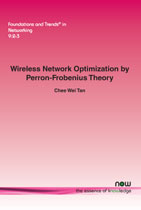Wireless Network Optimization by Perron-Frobenius Theory
By Chee Wei Tan, City University of Hong Kong, China, cheewtan@cityu.edu.hk
Abstract
A basic question in wireless networking is how to optimize the wireless network resource allocation for utility maximization and interference management. How can we overcome interference to efficiently optimize fair wireless resource allocation, under various stochastic constraints on quality of service demands? Network designs are traditionally divided into layers. How does fairness permeate through layers? Can physical layer innovation be jointly optimized with network layer routing control? How should large complex wireless networks be analyzed and designed with clearly-defined fairness using beamforming? This monograph provides a comprehensive survey of the models, algorithms, analysis, and methodologies using a Perron-Frobenius theoretic framework to solve wireless utility maximization problems. This approach overcomes the notorious non-convexity barriers in these problems, and the optimal value and solution of the optimization problems can be analytically characterized by the spectral property of matrices induced by nonlinear positive mappings. It also provides a systematic way to derive distributed and fast-convergent algorithms and to evaluate the fairness of resource allocation. This approach can even solve several previously open problems in the wireless networking literature. More generally, this approach links fundamental results in nonnegative matrix theory and (linear and nonlinear) Perron-Frobenius theory with the solvability of non-convex problems. In particular, for seemingly nonconvex problems, e.g., max-min wireless fairness problems, it can solve them optimally; for truly nonconvex problems, e.g., sum rate maximization, it can even be used to identify polynomial-time solvable special cases or to enable convex relaxation for global optimization. To highlight the key aspects, we also list several case studies of using the nonlinear Perron-Frobenius theoretic framework for applications in MIMO wireless cellular, heterogeneous small-cell and cognitive radio networks. Key implications arising from these work along with several open issues are discussed in this monograph.
Wireless Network Optimization by Perron-Frobenius Theory
A basic question in wireless networking is how to optimize the wireless network resource allocation for utility maximization and interference management. How can we overcome interference to efficiently optimize fair wireless resource allocation, under various stochastic constraints on quality of service demands? Network designs are traditionally divided into layers. How does fairness permeate through layers? Can physical layer innovation be jointly optimized with network layer routing control? How should large complex wireless networks be analyzed and designed with clearly-defined fairness using beamforming?
Wireless Network Optimization by Perron-Frobenius Theory provides a comprehensive survey of the models, algorithms, analysis, and methodologies using a Perron-Frobenius theoretic framework to solve wireless utility maximization problems. This approach overcomes the notorious non-convexity barriers in these problems, and the optimal value and solution of the optimization problems can be analytically characterized by the spectral property of matrices induced by nonlinear positive mappings. It can even solve several previously open problems in the wireless networking literature.
This survey will be of interest to all researchers, students and engineers working on wireless networking.
